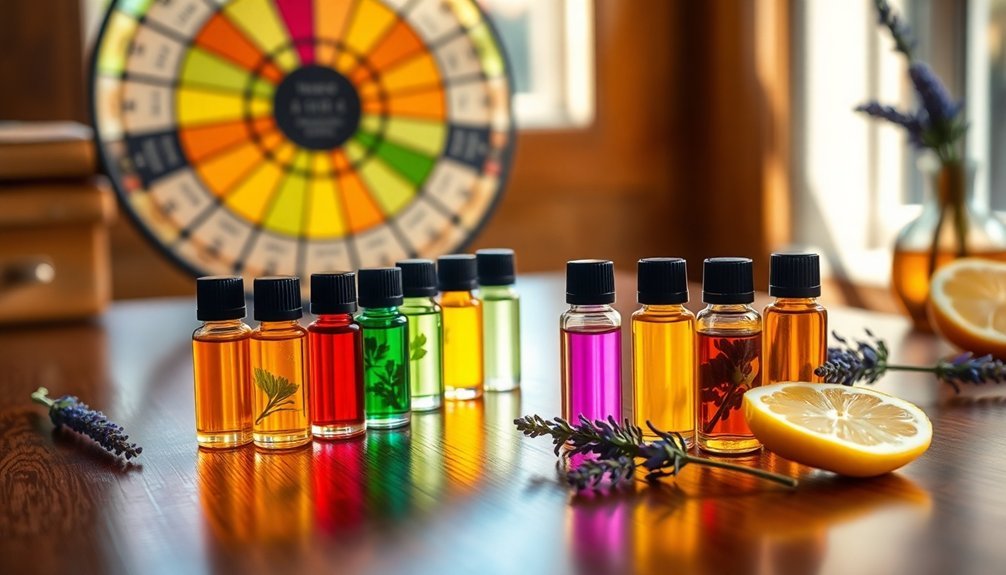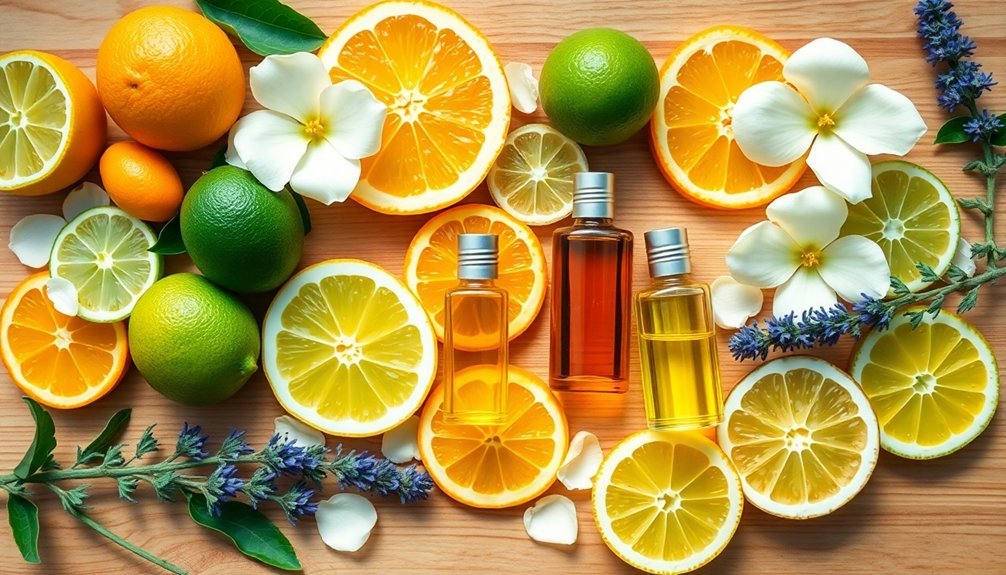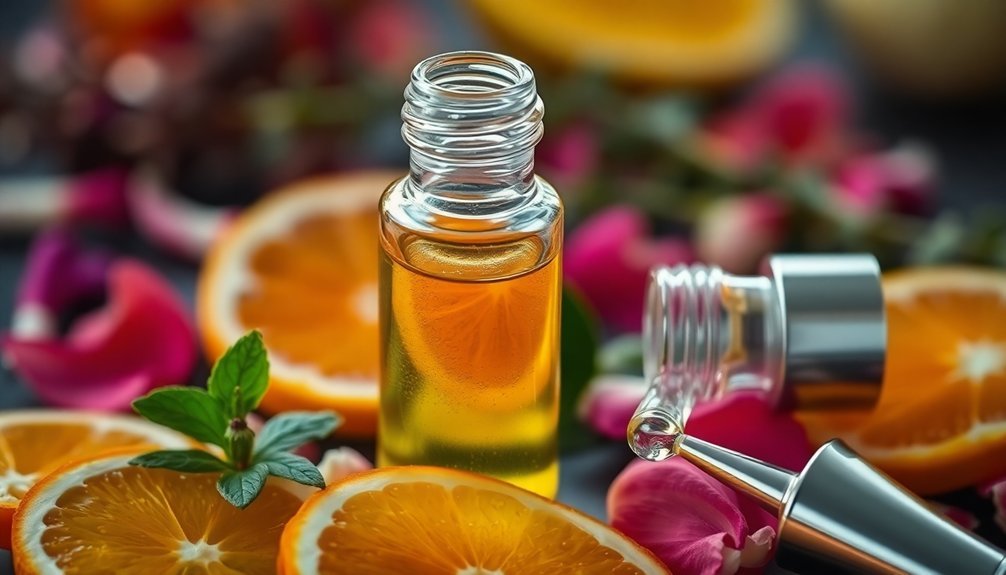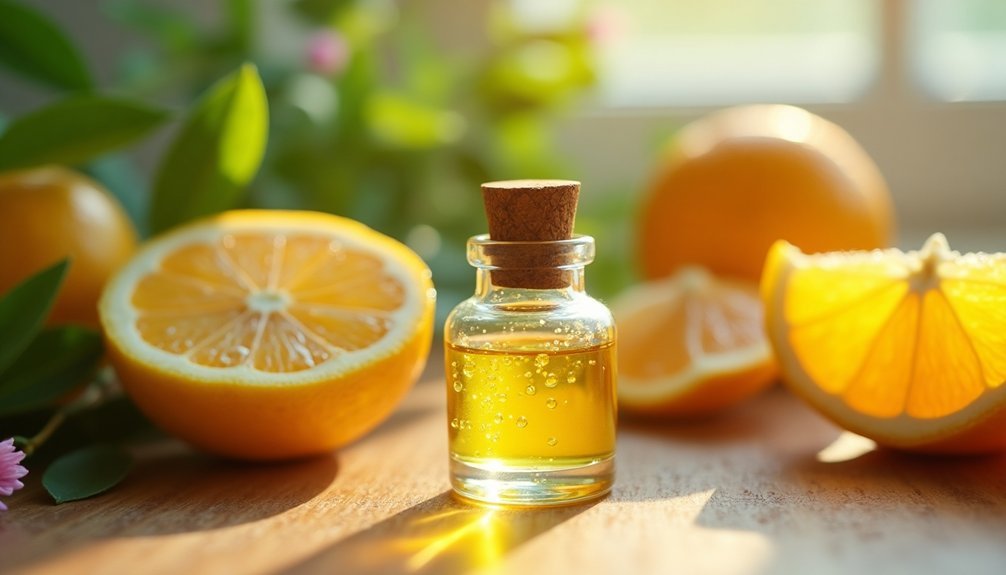To match top notes effectively, start with complementary citrus pairings like lemon and bergamot, or try herbal combinations such as lavender with mint. You'll want to maintain top notes at 30-50% of your total blend, measuring carefully with proper tools like scales and pipettes. Don't overcrowd your blend – stick to 2-3 compatible notes and consider seasonal appropriateness. The real magic happens when you understand how these bright initial notes interact with middle and base layers.
Understanding the Role of Top Notes in Fragrance Construction

Fragrances begin their story with top notes, the initial aromatic characters that greet your senses upon first application. When you're creating your own blend, you'll discover that these volatile notes play an important role in making a memorable first impression, typically lasting between 5 to 15 minutes before fading.
As you work with fragrance oils, you'll notice that citrus and fresh aromas like lemon, bergamot, peppermint, and eucalyptus make excellent top notes. These invigorating scents set the stage for your entire fragrance composition.
To create a well-balanced blend, you'll need to carefully consider how your chosen top notes interact with the middle and base layers. Remember that while these initial impressions are fleeting, they're essential in establishing the overall character and appeal of your fragrance.
Essential Tools and Materials for Top Note Blending
You'll need basic testing equipment like fragrance strips, a reliable scale, and pipettes to begin matching top notes effectively.
Keep your fragrance strips organized in labeled containers or envelopes to track your different combinations and prevent cross-contamination.
A dedicated storage system for your sample strips allows you to revisit and compare scents over time, helping you refine your blending skills and document your progress.
Basic Testing Equipment
Getting started with top note blending requires specific tools that guarantee accurate testing and consistent results.
You'll need blotter strips to evaluate fragrance combinations without applying them directly to your skin, allowing you to assess the strength and balance of each blend.
Keep a small glass vial handy to mix and store your successful top note combinations for future reference.
A reliable scale helps you measure precise amounts of essential oils, especially when you want to replicate a winning formula.
Don't forget to maintain a notebook or digital record to track your blending experiments, including ratios and observations.
Store your essential oils properly in a cool, dark place to preserve their potency and ensure your testing results remain precise over time.
Storage For Sample Strips
Proper storage of sample strips forms the foundation of accurate fragrance testing and development.
You'll need to keep your sample strips in a cool, dry place away from direct sunlight to maintain their integrity and prevent contamination from unwanted aromas.
To organize your blending process effectively, use a labeled storage box or file system that helps you track different fragrance combinations.
Keep your sample strips separate from essential oils and other scented materials to avoid cross-contamination.
You'll find that airtight containers are particularly useful for preserving the original scent profiles and protecting volatile top notes from evaporation.
Remember to inspect your strips regularly.
If you notice any discoloration or unusual odors, it's time to replace them.
This guarantees your fragrance testing remains accurate and reliable.
The Art of Selecting Compatible Citrus Notes

When you're combining citrus top notes, start by pairing complementary scents like Lemon and Bergamot to create a bright, complex foundation.
You'll want to balance sharper citrus elements with sweeter ones, such as mixing Blood Orange with Grapefruit to achieve a more rounded aroma.
To enhance your citrus combinations, try layering different intensities of brightness, allowing the strongest notes to lead while softer ones provide subtle support.
Compatible Citrus Pairings
Anyone exploring fragrance blending knows that citrus notes form the cornerstone of vibrant top notes. Top notes are usually volatile, so you'll want to pair them strategically with longer-lasting elements.
When creating complementary blends, try combining sweet Blood Orange with sharp Yuzu for a balanced profile that's both exciting and harmonious.
Your unique blends can become more dynamic when fragrance notes combine in unexpected ways. For instance, pairing Peppermint with Lemon creates an invigorating scent that keeps lingering in a room.
Before finalizing your combinations, test them on blotter strips to verify they work well together. Remember that citrus notes evaporate quickly, so balance them with substantial middle and base notes for a well-rounded fragrance that maintains its character throughout the day.
Layering Brightness Effectively
Masterful citrus layering begins with understanding how different bright notes interact and complement each other. When you're blending citrus scent combinations, start by selecting top notes that offer distinct characteristics – like pairing zesty lemon with sweet bergamot for a complex opening.
To create effective blend ideas, you'll want to reflect on how long your citrus notes will last. Since these bright elements typically fade within 5-15 minutes, you'll need to layer brightness strategically.
Try combining your citrus top notes with complementary middle notes like lavender or eucalyptus to maintain the scent's vibrancy as it develops. Each unique characteristic of your chosen citrus elements, whether it's the sharp punch of lemon or the floral undertones of bergamot, should flow seamlessly into the next layer of your fragrance composition.
Matching Herbal Top Notes for Balanced Compositions
Creating a balanced fragrance with herbal top notes requires a thoughtful approach to intensity and compatibility. When you're blending herbal top notes, pair them with citrus elements to achieve a harmonious fragrance composition. Since these notes only last 5-15 minutes, you'll need to take into account longevity in your overall blend.
| Herbal Note | Complementary Note |
|---|---|
| Lavender | Bergamot |
| Peppermint | Lemon |
| Rosemary | Thyme |
| Basil | Sweet Orange |
To create a unique aromatic experience, experiment with unexpected herbal combinations. You'll find that pairing complementary notes, like Rosemary and Thyme, adds depth to your blend. Remember to balance the intensity of your herbal top notes to guarantee they shift smoothly into the middle notes, creating a well-rounded fragrance that evolves beautifully.
Creating Harmony Between Floral and Fresh Top Notes

Moving beyond herbal notes, the combination of floral and fresh top notes opens up a world of exciting fragrance possibilities.
When blending these elements, you'll want to strike a delicate balance between romantic florals like Rose and Jasmine and invigorating citrus notes such as Bergamot and Lemon.
Start with a dominant fresh note and gradually add floral components until you find your desired harmony. Since top notes evaporate quickly, consider incorporating middle notes like Lavender to extend the fragrance experience and create a seamless bridge between the fresh and floral elements.
This approach guarantees the freshness enhances the floral richness without overshadowing it. Remember, the key is to let each note shine while maintaining a cohesive blend that suits your preferences and intended use.
Testing Techniques for Top Note Combinations
Three essential testing techniques help guarantee successful top note combinations in fragrance blending. Start by applying your complementary top notes to fragrance strips, letting them dry completely to accurately evaluate the blend's character.
You'll want to experiment with different ratios, typically starting with 2:1 or 1:1 proportions, as this affects how the aromas you'll smell develop over time.
Always allow your combinations to settle for several minutes before making any judgments. This waiting period is vital because the initial impression can be misleading due to the volatile nature of top and middle notes.
Keep track of your experiments in a fragrance journal, documenting which combinations work best and your personal reactions to each blend. This systematic approach will help you develop more refined blending skills.
Common Top Note Pairing Mistakes to Avoid

You'll want to watch out for combining multiple citrus notes like bergamot, lemon, and lime in the same blend, as they can compete with each other rather than create harmony.
When working with bright, energetic top notes, resist the urge to pack too many into your composition, as this often results in a chaotic and overwhelming opening.
Instead, focus on selecting complementary citrus notes that work together, such as pairing sweet orange with tart grapefruit, or limiting yourself to just one or two bright notes for a more balanced blend.
Clashing Citrus Combinations
While citrus notes can add a vibrant, energetic dimension to your fragrance blends, certain combinations can lead to sensory discord rather than harmony.
You'll want to avoid pairing similar citrusy top notes like lemon and lime, as they compete for attention rather than complement each other in your blend.
Instead of creating clashing combinations with sharp citrus notes like grapefruit and bergamot, try pairing one citrus top note with a contrasting middle or base note.
For example, blood orange works beautifully with floral notes, while citrus elements can find balance when grounded by deeper notes like lavender or vanilla.
When selecting your fragrance combinations, consider each citrus note's unique characteristics – from yuzu's energizing quality to eucalyptus's invigorating nature – to create more harmonious blends.
Overdoing Bright Notes
Creating a balanced fragrance requires careful restraint with bright top notes, as excessive use can quickly overwhelm your blend. When you're working with bright notes, you'll want to limit your selection to just a few key scents to maintain harmony and sophistication in your fragrance blend.
| Common Mistakes | Better Alternatives |
|---|---|
| Multiple citrus top notes | Single citrus + floral |
| Pure bright notes only | Bright + herbal balance |
| No anchoring base notes | Bright + woody foundation |
To guarantee proper longevity and depth in your balanced perfume, avoid the temptation to stack multiple bright notes together. Instead, complement your chosen top notes with softer middle notes like florals or herbs. This approach prevents the common mistakes of creating a one-dimensional scent that quickly fades after the initial impression.
Seasonal Considerations in Top Note Selection
Just as nature transforms with each passing season, your choice of fragrance top notes should evolve throughout the year.
Seasonal changes dramatically impact how different scents are perceived and experienced. You'll want to adjust your fragrance experience to match the environment around you.
Here's how to align your top notes with each season:
- Summer: Embrace light, citrusy scents like lemon and bergamot for a revitalizing feel
- Winter: Choose warm, spicy elements like cinnamon and clove to create cozy comfort
- Spring: Select floral top notes such as cherry blossom and jasmine to capture nature's renewal
- Autumn: Blend fruity and earthy notes like blood orange and apple to reflect harvest time
Measuring and Ratio Guidelines for Top Note Blends

Every successful fragrance blend relies on precise measurements and ratios of top notes to achieve the perfect opening impression.
You'll want to keep your top notes between 30-50% of your total blend to create a vibrant but balanced initial impression. Start by combining equal portions of each top note, then adjust based on your desired aromatic profile.
When you're working with different intensities, you'll need to measure carefully. Potent citrus oils typically require lower concentrations than subtle scents like peppermint.
Consider experimenting with layering two or three complementary top notes to develop a more complex opening. Remember that these scents will evaporate within 5-15 minutes, so their strength should be precisely measured to guarantee a smooth shift to middle notes.
Best Practices for Preserving Top Note Intensity
Now that you've mastered measuring your top notes, proper storage and handling will guarantee they maintain their vibrancy.
Your fragrance oil's longevity depends on how well you protect those delicate top notes from environmental factors that can diminish their intensity.
To preserve your blend's vibrant character:
- Store your essential oils in dark glass bottles away from direct sunlight and heat sources
- Keep containers tightly sealed to prevent oxidation from air exposure
- Choose glass over plastic containers, as glass won't react with your fragrance oils
- Limit your blend to fewer top notes to maintain each scent's distinct character
Frequently Asked Questions
How Do You Match Fragrance Notes?
You'll want to start with identifying scents you love, then pair complementary notes together. Mix similar families like citrus with citrus, or create contrast by combining florals with woody notes.
How to Blend Fragrance Notes?
Start with light top notes, then layer in middle and base notes. You'll want to test combinations on blotter strips, letting each layer dry before adding the next. Trust your nose's preferences.
What Fragrance Notes Go Together?
You'll find citrus notes pair well with herbs like rosemary and lavender. Try combining blood orange with jasmine, or peppermint with vanilla. Eucalyptus works nicely with coconut, while citrus complements sandalwood.
What Is the Ratio for Blending Perfume?
You'll want to start with a classic 30-50-20 ratio: 30% top notes, 50% middle notes, and 20% base notes. You can adjust these percentages based on your preferences while experimenting with small batches.
In Summary
Mastering top note blending takes patience and practice, but you'll find it incredibly rewarding. Start with small batches, keep detailed notes of your combinations, and don't be afraid to experiment. Remember to take into account seasonality and proper ratios when matching your notes. With these fundamentals in mind, you're well-equipped to create fragrances that make a memorable first impression and flow beautifully into their heart notes.





Leave a Reply